Text
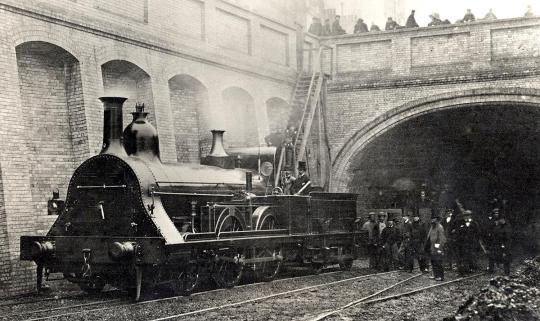
In 1861 John Fowler built a new type of steam locomotive for the use of working on the new Metropolitan Railway, which was Londons first underground railway. The design he came up with was an experimental fireless 2-4-0 locomotive. The broad gauge locomotive used exhaust recondensing techniques and a large quantity of fire bricks to retain heat and prevent the emission of smoke and steam in tunnels. As the Metropolitan Railway was still two years from completion, the first trial was held on the broad gauge Great Western Railway in October 1861 on the line near Hanwell railway station. The trial was a failure, with the locomotive completing only 7.5 miles. The condensing system leaked, causing the boiler to run dry and the steam pressure to drop. As a result, the boiler feed-pumps jammed, creating a dangerous situation where the boiler could have overheated resulting in an explosion. After trials on the Great Western Railway in 1861 and another in London in 1862, the locomotive was considered a failure; on its first trial it was near to exploding, and problems with steaming and pressure retention were never resolved. The locomotive was sold in 1865 with the intention to convert it into a conventional steam engine, but it was quietly scrapped in 1895. The locomotive was considered an embarrassment to its designer, the respected engineer John Fowler and its existence was denied for many years; the name "Fowler's Ghost" was given to it by The Railway Magazine in a retrospective article in January 1901, and this has subsequently become the standard reference name for the engine.
#locomotive#train#trains#steam locomotive#great britain#britain#british#failed experiment#experimental#ghost#Fowler#fowlers ghost#metropolitan railway#scrapped
43 notes
·
View notes
Text

Between 1928 and 1930 the Union Pacific Railroad ordered 88 locomotives from the American Locomotive Company, otherwise known as ALCO, for use on freight trains with the intended purpose of making these freight trains move faster. How did they go about with this? Stream lining? Building massive articulated mallets? No. Instead they built a 3 cylindered engine that used Conjugated Valve Gear, which was invented by Sir Nigel Greasly (the cheif mechanical engineer of the LNER over in Great Britain), and was a non-articulated 4-12-2 type locomotive. These massive engines were known as the Union Pacific 9000 class.
The UP 9000 class was impressive in multiple ways. First of all holding the record for being the only locomotives to ever have the 4-12-2 wheel arrangement, being called the "Union" type after the Union Pacific Railroad, and for having nearly 100,000 lbf of traction effort. However, these machines were plagued by mechanical short bringings. They were maintenance nightmares, largely because of their use of an inside third cylinder driving the cranked second driving axle between the frames. The Conjugated Valve Gear also gave mechanics problems, so much so that between 1934 and 1940 eight of the first fifteen locos had their Gresley gear removed and were converted to a "double Walschaerts" valve gear which utilized a double eccentric (return) crank and second link on the right side, which operated the valve for the inside cylinder. Union Pacific referred to this system as the "third link." The 4-12-2's constructed from 1928 utilized roller bearings in the Gresley lever bearings, thus none of these engines were converted. The pre-1928 engines not converted received the roller bearing levers in 1940, and no further conversions were made. Not only did their inability to be worked on a issue but the fact that they were non-articulating and so long limited their route availability; they were only able to run on track that was straight enough not to derail the engine or damage the track it ran on. Only one example has survived into preservation. Union Pacific No. 9000 is preserved at the Railway and Locomotive Historical Society's museum at the Los Angeles County Fairplex in Pomona, California.
#locomotive#train#trains#steam locomotive#american locomotive#america#alco#union pacific#9000#sir nigel greasly#greasly#up#uprr
51 notes
·
View notes
Text
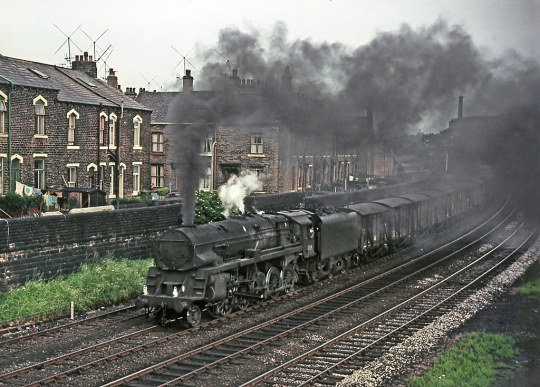
The British Railways (BR) Standard Class 9F 2-10-0 is a class of steam locomotive designed for British Railways by Robert Riddles. The Class 9F was the last in a series of standardised locomotive classes designed for British Railways during the 1950s, and was intended for use on fast, heavy freight trains over long distances. It was one of the most powerful steam locomotive types ever built for British Railways, and successfully performed its intended duties. The class was given the nickname of 'Spaceships', due to its size and shape. In 1955 BR experimentally built 10 9F's at Crewe Works; these 10 were fitted with Franco-Crosti boilers. The Franco–Crosti boiler is a type of boiler used for steam locomotives. It was designed in the 1930s by Attilio Franco and Dr Piero Crosti. The main difference between it and conventional feedwater heaters widely used on the continent is that the Franco-Crosti boiler uses both exhaust steam and exhaust gases from the firebox. Conventional feedwater heaters only use exhaust steam. The Franco-Crosti boiler took the form of a single cylindrical water drum running along the underside of the main boiler barrel; the standard chimney at the front was only used during lighting-up, in normal working the gases went through firetubes inside the preheater drum that led to a second smokebox situated beneath the boiler from which there emerged a chimney on the right-hand side, just forward of the firebox. However; the experiment did not deliver the hoped-for benefits, and efficiency was not increased sufficiently enough to justify the cost and complexity. Moreover, conditions were unpleasant on the footplate in a cross-wind, this in spite the later provision of a small deflector plate forward of the chimney. These problems led to the subsequent sealing off of the preheater drum, over the period of 1959 to 1961, and the locomotives were then worked conventionally. As a result of this, there was a reduced ability to generate steam, and so their power classification was reduced from 9F to 8F. No. 92028 was the first Franco-Crosti 9F to be withdrawn in October of 1966, No. 92027 followed in August of 1967, with the remainder being withdrawn en masse in November of 1967. All were scrapped, with none surviving into preservation.
#locomotive#train#trains#steam locomotive#british railways#br#franco-crosti#9f#failed experiment#experimental#crewe works
42 notes
·
View notes
Text
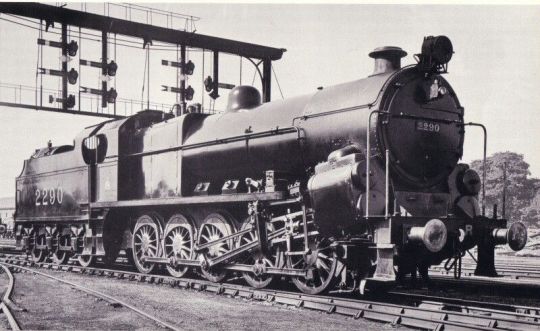
In Britain very rarely does the need arise for a locomotive with 10 driving wheels, the only locomotives with such design include the 0-10-0 tank engine "Decapod" built by the Great Eastern Railway (GER) and the 2-10-0 British Railways (BR) standard class 9F's and of course the 0-10-0 tender locomotive built by the Midland Railway (MR) shown in the picture above.
In 1919 the Midland Railway built a single 0-10-0 steam locomotive to the design of James Anderson; its purpose was to fulfill the banking duties on the infamous Lickey Incline in Worcestershire, England (the steepest sustained main-line railway incline in Great Britain). The engine became known as "Big Bertha" or "Big Emma" by railwaymen and railway enthusiasts; as time went on she was inherited by the London, Midland and Scottish Railway (LMS) after the Midland Railway was annexed into the LMS and then inherited by British Railways (BR) when nationalization happened. With a weight of 107 tons and 10 driving wheels with a diameter of 4 ft 7 1⁄2 in, she had a tractive effort of 43,300 lbf. She was the only locomotive not given a power classification by either the LMS or BR, since she was designed specifically for the job of providing extra power over the Lickey Incline and was not suitable for normal train working. The engine was withdrawn on May 19th 1956 and scrapped by Derby Works in September 1957, having covered 838,856 miles mostly on the Lickey Incline. BR standard class 9F No. 92079 took over her roll, even acquiring Big Bertha's electric headlight for the duty.
Here is British Railways 9F No. 92079 with Big Bertha's electric headlight.

#locomotive#train#trains#steam locomotive#british railways#midland railway#br#mr#lms#london midland and scottish railway#0-10-0#2290#br class 9f#9f#92079#lickey incline#britain#great britain#british#scrapped
43 notes
·
View notes
Text

Probably the most iconic 2-8-2 Mikado steam locomotives to ever come out of Britain were the P2 locomotives designed by Sir Nigel Greasly for the London and North Eastern Railway (LNER), however not many people know of the P2's older brother, the P1.
In 1923 Sir Nigel Greasly submitted the design for what initially was going to be a stronger 2-10-0 version of the class O2 2-8-0's; however this design was changed to a 2-8-2 Mikado type steam engine. The P1's were the most powerful freight locomotives ever designed for a British railway. Only 2 were ever built, the first P1, No. 2393, was completed by Doncaster in June of 1925 and was shown at the Darlington Centenary celebrations in July, with its sister No. 2394 being completed in November 1925. Both were externally rather similar, although No. 2393 had a 32-element superheater while No. 2394 had a larger 62-element 'E' type superheater. They were the first 2-8-2 locomotives to be built in Britain for local use (although not the first designed). Both were allocated to New England shed after completion where they were subjected to regular testing. In service, the P1s could handle 100-wagon coal trains, although these were an operational hazard due to their overhanging track circuits and being too long for many of the passing loops. They were also coal-hungry engines, with a 1926 Locomotive Inspectors Conference Report stating that the engines used 131 pounds per mile of coal. However, they were still thought of highly enough in 1926 that it was proposed to build another four P1s to replace an equivalent number of 0-8-0s. The two P1s were only ever used between New England and Ferme Park, the only route deemed suitable for them by the Operating Department. In practice there were issues with running such large trains with such powerful engines, one of which being hungry for steam requiring even more coal; as a result turns firing the P1s were considered as ones to avoid. It was also found that the heavier trains that the P1s could handle were too long for many of the passing loops resulting in delays to passenger trains. The result was that they were considered uneconomic as they were generally used in hauling trains of less than the 1,000 long tons for which they were built. In 1934 No. 2394 was experimentally tried on the 07:45 AM semi-fast passenger train from Kings Cross to Peterborough as part of the planning stage for P2 class locomotive 2001 Cock o' the North. Although the engine was able to reach a maximum speed of 65 mph, this put too much stress on the fireman who later commented that he was thankful not to have been going beyond Peterborough. In 1942, both engines were overhauled and their original boilers, then in very poor condition, were replaced with A3-type 220 lbf/in2 boilers and their cylinder diameter was reduced to 19 inches, leading to an increased tractive effort of 42,500 lbf. The valve motion was retained in its original short-lap travel configuration. This rebuilding, which took place in November and January of 1942 for engines No. 2393 and No. 2394 respectively, after this they were reclassified as P1/2's. Due to the reduction of heavy freight trains after the Second World War, both engines were withdrawn by Edward Thompson in July of 1945 and both were unfortunate scrapped, and became the first Gresley locomotives to be withdrawn and scrapped by intention.
#locomotive#train#trains#steam locomotive#lner#london and north eastern#mikado#sir nigel greasly#edward thompson#2-8-2#great britain#britain#british#scrapped
39 notes
·
View notes
Text
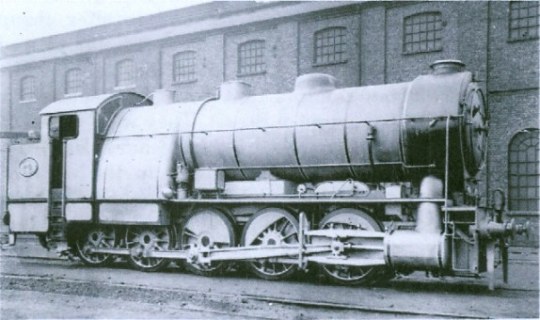
In 1902 the Great Eastern Railway (GER) built a single 0-10-0 tank locomotive to the design of the GER Chief Draughtsman, Fred Russell, under the supervision of the Chief Superintendent, James Holden. The locomotive was built for purely political purposes in order to block the passage through Parliament of a new rival scheme for an electric railway. The aim was to demonstrate the ability of a steam locomotive to accelerate passenger trains at a rate comparable to electric traction and the electric trams with which the GER was also in competition over short distances. The locomotive was far larger than any locomotive previously built in Britain for home service and was the first ten-coupled steam locomotive in Great Britain. The locomotive had 10 four-foot-six-inch driving wheels, which gave the engine a high tractive effort of 38,788 lbs. Three cylinders were used because there was insufficient room for two cylinders large enough to develop the required tractive effort without going up to a higher boiler pressure. Even so, it still had to have a pressure of 200 psi to achieve the required result. The locomotive was given the classification of A55 but was usually referred to as the "Decapod". The specification required that the locomotive should accelerate 315 ton train from a stand to 60-mile-per-hour in 29.2 seconds. According to Ahrons, "Holden's engine actually accelerated a new train of 18 carriages weighing 335 tons at a rate of 1.4 feet/second in very windy weather". A axle load at 16.75 tons, was not excessive, but weight per foot run of wheelbase was very high and using a class of these engines would have necessitated considerable strengthening of bridges; thus whilst it achieved its aims, nothing resulted from the experiment. In 1906 it was rebuilt as a 0-8-0 tender engine and reclassified as a A55R but its performance wasn't up to what the GER was looking for so the locomotive was scrapped in 1913.
#locomotive#train#trains#steam locomotive#decapod#great eastern railway#great britain#britain#british#failed experiment#experimental#ger#scrapped
46 notes
·
View notes
Text

"The Great Bear" designed by George Jackson Churchward was a machine you wouldn't normally see on the Great Western Railway (GWR), on a railway filled to the brim with 4-6-0 locomotives this 4-6-2 pacific really stood out. "The Great Bear", or No. 111, was built in February of 1908 in Swindon Works and was the only locomotive of its kind ever built. There are differing views as to why Churchward and the GWR should have built a Pacific locomotive in 1908 when the current and future locomotive practice for the GWR was centred on the 4-6-0 wheel arrangement. One suggestion is that The Great Bear was built in 1908 to satisfy demands from the directors to build the largest locomotive in Britain, and much was made of the locomotive by the GWR's publicity department. However, O. S. Nock was adamant that the design "was entirely due to Churchward, and not to outside influences that pressed the project upon him". Nock regarded the locomotive as "primarily an exercise in boiler design", with Churchward looking forward to a time when his Star Class locomotives could no longer cope with increasing loads. The front-end layout of the class was the same as that for the Star Class except that Churchward fitted 15 inch diameter cylinders, the maximum possible without fouling the rear wheels of the front bogie. However, the design of the boiler was entirely new, and with a barrel of 23 ft in length, which was exceptionally long both by contemporary and later standards. The main reason Churchward adopted the 4-6-2 wheel arrangement was to enable him to fit a wide firebox over the trailing wheels. With a firebox surface of 182 sq ft this was a 17.5% increase in size compared to the Star Class. It was also built with a Swindon No. 1 superheater. In service, the performance of The Great Bear proved to be disappointing and not a significant improvement on existing classes. "The excessive tube and barrel length of 23 feet made for bulk rather than efficiency". Also, the axle boxes of the trailing wheels tended to become overheated due to their proximity to the firebox. Churchward attempted to improve the locomotive's performance by adding a Swindon No. 3 Superheater in 1913 and top-feed apparatus. However, the excellent performance of the Star Class and the advent of the First World War brought a stop to further experimentation without significant improvement. Although not a technical success, The Great Bear was considered the company's flagship locomotive from its introduction until Churchward's retirement in 1922. With the introduction of 4073 Caerphilly Castle in 1923 with a higher tractive effort, The Great Bear ceased to have any publicity value and became an embarrassment. It was due for heavy repairs in January 1924 and so was withdrawn from service by Churchward's successor Charles Collett. It had then completed 527,272 miles in service. No. 111 emerged as a 4-6-0 in the Castle Class, given the name "Viscount Churchill". Thereafter, the GWR did not use the Pacific wheel arrangement on any of its future designs. No. 111 was withdrawn in July 1953 and was unfortunately scrapped later that year.
#locomotive#train#trains#steam locomotive#gwr#great westsrn railway#the great bear#111#churchward#collett#pacific#failed experiment#british#britain
39 notes
·
View notes
Text
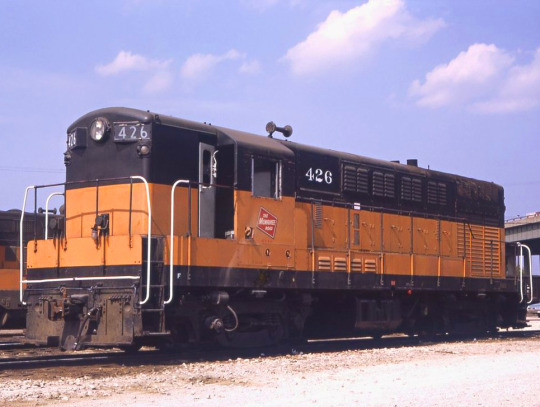
Fairbanks, Morse and Company was an American manufacturing company in the late 19th and early 20th century. Originally a weighing scale manufacturer, it later diversified into pumps, engines, windmills, coffee grinders, radios, farm tractors, feed mills, and industrial supplies until it was purchased by Penn Texas in 1958 and later, in 1999, by Goodrich Corp. However in 1935 Fairbanks-morse decided it wanted to dip its toes into the railway industry and started making plans on building locomotives. The locomotive shown above is one such locomotive types built by F-M, the H-16-44 was a diesel road switcher produced by Fairbanks-Morse from April 1950 to February 1963. The locomotive shared an identical platform and carbody with the predecessor Model F-M H-15-44 and was equipped with the same eight-cylinder opposed piston engine that had been uprated to 1,600 horsepower. The H-16-44 was configured in a B-B wheel arrangement, mounted atop a pair of two-axle AAR Type-B road trucks with all axles powered. In just these 13 years exactly 299 H-16-44 locomotives were produced and sold; 209 were built for American railroads, 58 were manufactured from March 1955 to June 1957 by the Canadian Locomotive Company for use in Canada, and 32 units were exported to Mexico. They had a top speed of 65 mph and a traction effort of 42,125 pounds; they were pretty reliable locomotives and did what they were intended to do very well but according to mechanics who worked on these engines the opposed piston design made them a living nightmare to fix and other accounts from locomotive drivers say that the opposed piston engines had trouble cranking over in colder conditions. Only three intact examples of the H-16-44 are known to survive today; one is the property of a Canadian railroad historical society, while the others are owned by Chihuahua al Pacífico and displayed in front of two of their depots in Mexico.
#locomotive#train#trains#american locomotive#fairbanks-morse#diesel electric#america#canada#mexico#diesel#diesel locomotive#opposed piston
49 notes
·
View notes
Text

The Metropolitan Railway H Class consisted of eight 4-4-4T steam locomotives (numbered 103-110) built by Kerr, Stuart & Co of Stoke on Trent in 1920 at a cost of £11,575 each. A "notable addition" to the Metropolitan Railway, these locomotives were purchased for the express passenger trains on the mainline between Harrow (later Rickmansworth)-the change point from electric locomotives-and Aylesbury or Verney Junction. They were designed by The Met's Locomotive & Chief Electrical Engineer, Charles Jones. Delivered between October 1920 and June 1921, they allowed for the retirement of a like number of 0-4-4T C Class and 2-4-0T D Class locomotives. The H Class were considered to be good engines well-suited to the express trains they worked, allowing for a reduction in running times of up to six minutes. They were designed with a hauling capacity of 250 long tons and could negotiate curves of 300 feet radius. When the steam-hauled services were transferred from London Transport to the London and North Eastern Railway in 1937, all eight H Class locomotives were included to continue working the same trains. The LNER numbered them 6415–6422 and reclassified them as H2 Class. In the 1940s, they were moved from Neasden shed to the Nottingham area and worked over other parts of the former Great Central Railway system; however even though they were very good locomotives they never reached 30 years of service, all being retired and scrapped between 1942 and 1947.
45 notes
·
View notes
Text
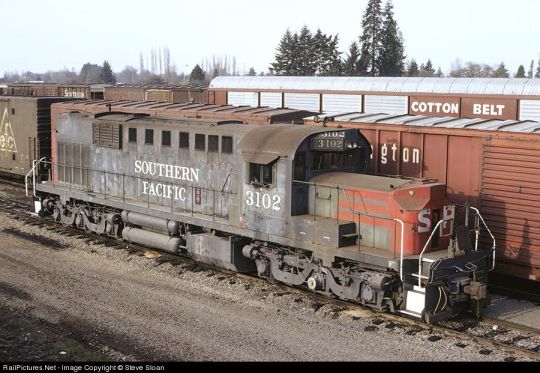
The Alco RSD-15 was a diesel-electric locomotive of the road switcher type built by ALCO between August 1956 and June 1960, during which time only 75 locomotives were produced. The RSD-15 was powered by an Alco 251 16-cylinder four-cycle V-type prime mover rated at 2,400 horsepower; it superseded the almost identical Alco 244-engined RSD-7, and was catalogued alongside the similar but smaller 1,800 hp RSD-12, powered by a 12-cylinder 251-model V-type diesel engine. The locomotive rode on a pair of three-axle Trimount trucks with all axles powered by General Electric model 752 traction motors. These trucks have an asymmetrical axle spacing because of the positioning of the traction motors. The six-motor design allowed higher tractive effort at lower speeds than an otherwise similar four-motor design. The RSD-15 could be ordered with either a high or low short hood; railfans dubbed the low short hood version "Alligators", due to their unusually long low noses. Out of 75 locomotives only 6 RSD-15's survive today, all of them ex-santa Fe units, and out of those 6, 2 of them are operational.
70 notes
·
View notes
Text

In 1944 Baldwin Locomotive Works built 20 massive 2-8-8-4 "Yellowstone type" engines for the Baltimore & Ohio Railroad (B&O) and another 10 in 1945, making a total of 30 engines, the B&O's EM-1 class, some of the last steam giants, a class that could rival the Union Pacific's Big Boys; weighing in at 1,010,700 pounds and spanning 83 ft 2.9 in in length. The need for such a locomotive to be built was the outbreak of World War 2; the war caused a surge in rail traffic all over the U.S. and railroads needed bigger and stronger engines to keep up with demand. The B&O wanted to use diesel power but the War Production Board regulated the production of steam and diesel locomotives until the war emergency was over. The EM-1 produced 115,000 pounds-force of tractive effort on 64-inch drivers with 235 pounds per square inch steam pressure and four 24-by-32-inch cylinders. The tender carried 22,000 US gallons of water and 25 tons of coal. Nothing bigger could operate within the tunnel clearances and track restrictions on the B&O's main line. They pulled heavy freight trains for the B&O, as well as the occasional mail and passenger trains, until 1957 where most of them were retired and scrapped, the last run of a EM-1 was on April 19, 1960. But one locomotive, No. 659, almost made it to preservation. The B&O Railroad Museum in Baltimore selected this locomotive as one of their future museum exhibits. However, there was a mix-up in communication, regarding the locomotive’s status, the salvage crew scrapped No. 659, where it stood. Now, none of the EM-1's survive.
#locomotive#train#trains#steam locomotive#american locomotive#b&o#em-1#yellowstone#world war 2#scrapped#no survivors#baldwin locomotive works
92 notes
·
View notes
Text

The L&YR Class 26 was a class of 20 2-6-2 T passenger steam locomotives of the Lancashire and Yorkshire Railway designed by Henry Hoy and introduced in 1903. Hoy intended the class to work Manchester, Rochdale, Oldham and Bury services where heavier trains and on lines gradients were giving difficulties to the Aspinall 2-4-2T radial tank locomotives. To a degree they were an evolutionary design based on the enlarged version of the 2-4-2T radial tanks with six-coupled wheels and the belpaire firebox used on the Aspinall Atlantic High Flyers and Coal engine 0-8-0 types. On their introduction in 1903 they were allocated to Liverpool to Southport workings covering a temporary shortage of electric stock; they were subsequently placed on their intended routes where they had an initially successful introduction. Problems with the class shortly emerged. Their heavy weight was not good for the track and the long rigid wheelbase put pressure on rails with severe curves in sidings. The flanges were removed from the centre driving wheels which eased some issues but increased the risk of derailment on track which was slightly out of alignment and particularly notably at junctions, flangeless driving wheels working better on smaller wheels placed closer together. The side tanks had a propensity to severely leak and they gained a reputation for poor stopping ability. When George Hughes produced a superheated upgrade to the 2-4-2T radial tanks they were able to perform the services allocated to the 2-6-2Ts and the latter were removed from passenger services in 1913 and placed on banking and shunting duties with water pickup equipment and coal rail removed for increased visibility for these duties. They were not best suited to these duties due to large 5 ft 8 in driving wheels and having the flanges on the centre wheels removed. They were passed on into the ownership of the London, Midland and Scottish Railway (LMS) in the grouping act of 1923 and given the power classification of 3F, they were withdrawn soon afterwards with none remaining in service after 1926. All were scrapped, leaving no survivors.
#locomotive#train#trains#steam locomotive#steam#l&yr#lms#london#tank locomotive#tank engine#radial tank#scrapped#no survivors
46 notes
·
View notes
Text
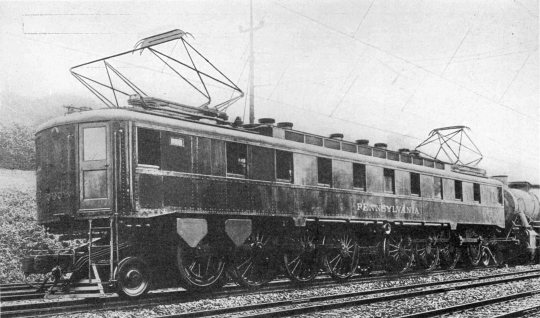
In 1917 Altoona works with Westinghouse built a single electric locomotive for the Pennsylvanian Railroad, a prototype design designated as a FF1 numbered 3931, eventually given the nickname "Big Liz". It was built to haul freight trains across the Allegheny Mountains where the PRR planned to electrify. "Big Liz" proved workable but too powerful for the freight cars of the time with its 4600 available horsepower and astonishing 140,000 lbf of tractive effort. Pulling the train it regularly snapped couplers and when moved to the rear as a pusher its force was sufficient to pop cars in the middle of the train off the tracks. In total this behemoth was 76 feet and 6 inches in length, 14 feet and 8 inches tall and weighed in at 516,000 pounds. However, though she was powerful and massive the locomotives top speed peaked at 20.6 mph. She had a 2-6-6-2 wheel arrangement in two half-frames, connected in the center. Each frame had a pair of three-phase AC induction motors driving a jackshaft through gearing and a spring drive; side rods then drove the wheels. The jackshafts can be mistaken for an additional fourth axle but the "wheels" are cogwheels to transfer power from the motors to the jackshaft. Three-phase power for the 4 massive motors was supplied from the single phase overhead supply via a large rotary converter housed in the body of the locomotive. With three-phase induction motors there was no way to control the speed of the motors; changing the wiring of the motor poles allowed for two speed settings, 10.3 and 20.6 mph, which were considered enough to drag heavy freight trains up and down steep grades. Its intended use as an Allegheny climber never realized and its power too much for the rolling stock in service at the time, Big Liz was sidelined until being cut up for scrap in 1940.
#locomotive#train#trains#american locomotive#pennsylvania#electric#westinghouse#altoona#Pennsylvanian railroad#electric locomotive
46 notes
·
View notes
Text

While Great Britain has made hundreds of Garratts for export to Africa and many other countries around the world not many people know that at one time there were a fleet of standard gauge garratt locomotives working solely for the London, Midland and Scottish Railway (LMS) between 1927 through 1958.
After Grouping the LMS continued the Midland Railway's "small engine policy" of hauling trains using two or three locomotives of moderate power coupled together. This led to most of the Toton (Nottinghamshire)-Brent (London) coal trains being double-headed by 0-6-0 locomotives. It was realised that double heading was uneconomical so a Garratt locomotive was ordered from Beyer, Peacock and Company. Three locomotives were built in April 1927 and the remaining 30 were built in the period of August to November 1930. All were built with straight sided bunkers, but from 1931 all except the first two of the 1927 trio were fitted with revolving coal bunkers. These were conical in shape and were revolved and oscillated by means of a small 2-cylinder steam engine. The revolving bunkers prevented coal dust from entering the cab and the oscillation facility made them self-trimming. The 33 garratts were used as heavy freight locomotives and they produced nearly 46,000 pounds of traction effort, they were not ever given a power classification. However, though they were a strong class of locomotive, they didn't go without their problems; they would break away from their trains when going up hill, their brake blocks would melt and the Derby works insisted on fitting their standard axleboxes to the design. These axleboxes were barely adequate for the LMS Class 4F 0-6-0 locomotives, on which they frequently overheated, and were a major weakness on the LMS Garratts. They were also always heavy on coal and maintenance. They were passed into British Railways ownership and the class was withdrawn between June 1955 and April 1958. None survived into preservation.
#locomotive#train#trains#steam locomotive#british railways#br#lms#derby locomotive works#beyer peacock & co.#garratt#garratt locomotive#failed experiment
47 notes
·
View notes
Text

The IC3 (or class MF) is a Danish-built high-comfort medium/long distance diesel multiple-unit train. The sets were built by ABB Scandia (later purchased by Adtranz, which itself was subsequently acquired by Bombardier Transportation) in Randers. This train model has been operating in Denmark and Sweden since 1989 and are still operating today. The name indicates simply that it is a three-carriage InterCity trainset. Development of the IC3 started in 1984, production started in 1986, and they entered service in 1991. However, its roots can be traced back further. In 1972, DSB celebrated its 125th anniversary, and at the same time made some large changes. First of all, two years later, in 1974, a completely new timetable system, the K74, was introduced. Secondly, the concept of lyntog were removed as the foundation of the long-distance traffic, and instead a new InterCity concept took over that role. After a few years, a new concept emerged, the so-called APOs, which were work-groups tasked with specific areas. There were groups for electrical locomotives, diesel-powered locomotives, and others, including the "long distance train" APO group. The long-distance train - APO was originally tasked with finding a suitable train for long-distance traffic. However, it was later rumoured that the lyntog-concept might be re-introduced within a few years, and so it was decided to find a suitable design for that concept. Several requirements were made: primarily to use air-conditioning for cooling and heating of passenger areas, and be able to use either electric or diesel propulsion. The second requirement were due to the fact, that the Danish politicians had yet to decide whether or not to fund a proposed electrification of the mainlines of the Danish railroads. At the time, no such train were available, so the group designed one themselves. In order to avoid propulsion units in the train (and thus reducing variants and development costs), it were designed to use a locomotive to haul it, and equip the end wagons with driver cabins. The train were designed a set of 5 wagons, with a service wagon in the middle (containing a small kiosk, and other facilities) and 4 passenger wagons. The first IC3 set was delivered in 1988, but unfortunately suffered from a number of teething problems, primarily due to its (at the time very advanced) computer systems. One example was that it would lock the toilet door with no apparent reason (it was programmed to lock the door when either someone was in there and requested so via a button, or when the toilet-system suffered a problem). Another issue was that snow would build up around the diaphragms blocking the drivers view. By late 1990, the majority of these problems had been solved, and so the train entered service in 1991. In 2017, DSB announced the IC3 stock would receive a 10 year life extension, allowing them to replace IC4 trains. In 2018, the first ERTMS-retrofitted IC3 left the workshop. All IC3's are to be converted to ERTMS from the proprietary ZUB 123 ATC. DSB will try out mass producing the conversion on the remaining IC3's in the fall of 2019.
28 notes
·
View notes
Note
Could you make one about the Danish IC3? DSB has announced that it's finally gonna fully electrify the railways so that means that these diesel engines will probably be taken out of service in the next few years. They've served reliably and faithfully for 30 years now and have been more or less the only train I've known since I live in the part of the country that wasn't electrified. Also I'd just love to see some Danish trains in general :)
Of course I will, at the moment I'm sort of busy but expect a post about them soon!
1 note
·
View note
Text

The Milwaukee Road's class ES-2 comprised four electric switcher locomotives. Two were built in 1916 and the final two in 1919. They were of steeplecab design, with a single roof-mounted pantograph to access the Milwaukee's 3,000 V DC overhead line. Originally numbered 10050–10053, they were renumbered E80–E83 in March 1939. The ES-2 was the Milwaukee Road's primary class of dedicated electric switchers. They produced a nice 475 horsepower and despite their highly specialized niche on the Milwaukee Road, the ES-2s were well-liked by personnel. Engineers liked them due to their rapid throttle response, preferring them over diesels which were slower to transition and accelerate. Their simple nature made them easy to service, and the units seldom needed major attention. Few changes were made to them over the years, the most important of which was the addition of extra steel plates, which added weight and reduced wheelslip. Engine E83 became surplus and was scrapped in 1952 while the last 3 survived all the way to the end of the electric operations on the Milwaukee Road (June 15, 1974). Unfortunately the last 3 were retired from service not long after and were scrapped and thus there are no more of these funky little electric switchers around anymore.
28 notes
·
View notes